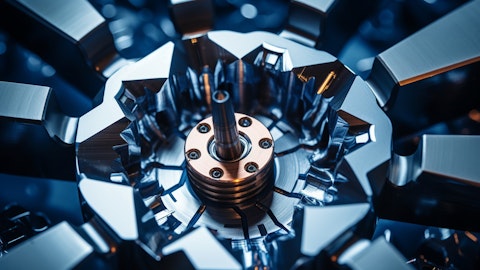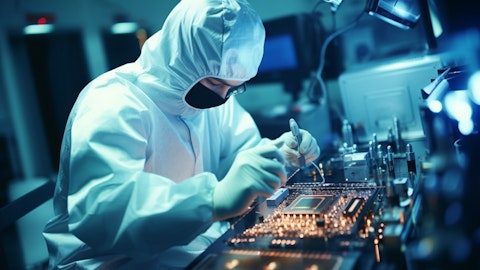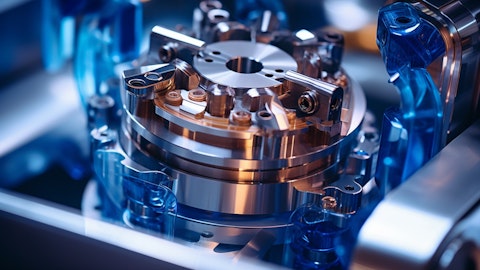Greg Swyt: Yes. About half of the miss on the components. Not expediting, we are not seeing any of that now in the market from supply chain on fees and things like that. It’s more about the customer mix with inside of the components.
Jeff Andreson: Specifically in machining, when you are starting to ramp up, you are doing smaller lot quantities, so you are just not – you are not getting as much throughput. So, it’s almost equates to like a learning curve. And as the more volume you get, the lower the average cost per unit will come down. So – and we just didn’t hit what we thought we could coming out of the gates.
Tom Diffely: Okay. That’s helpful. And then when you look at the proprietary products that you have going forward weldments, fittings, precision machining, which of those do you think is the biggest market for you ultimately? And is there any type of a margin difference between the three?
Jeff Andreson: I would say from the least sophisticated more ubiquitous types of parts, they are probably in the low-30s and you might get into the low-40s. So, the range is not that far off from them. I would say the markets that we address today in precision machining and things like that are kind of measured in billions and components and things like that. So, there are big opportunities. Individually, I would say the flow controllers are the ones that can help move the needle the most in the long-term. But in the near-term, it’s definitely going to be the components I have mentioned on the conference call because those are going into existing gas panels, we manufacture today so that they are also going on the new stuff, but the new stuff, obviously, is in early stages of qualifications.
Tom Diffely: Okay. That’s helpful. And then finally, when you look at – you talked about some inventories that you needed to burn off. But at what point do you need to start building inventory for gas panel? And how far before revenue do you start to see that?
Jeff Andreson: Well, I would say maybe the way to think about it, Tom, is that when we will know the inventory burn is largely gone when we see our component business start to inflect because they have the longest lead times. I mean our contractual lead times are three weeks, four weeks for gas panels. They are longer than that for the EUV gas delivery, but the volumes are much, much smaller, obviously. So, we usually see it on the components side, first. And that’s still running fairly sideways for us in the first half of the year.
Tom Diffely: Okay. Thank you.
Jeff Andreson: You bet. Thanks Tom.
Operator: Our next question will come from Ross Cole with Needham & Company.
Ross Cole: Hi. Thank you for taking my question. I am on behalf of Charles Shi. So, in the past, you had mentioned that you expect the two largest OEMs to reach a restocking point in the second half this year. Do you still think that’s the case that they might not want to wait until inventory get back to historical normal levels, or do you think that the management of those companies will still want to maintain a higher inventory buffer than they have in the past?
Jeff Andreson: I would say – I don’t know what levels of buffers. I know that we are carrying higher levels of buffers, which should alleviate their need to do it. So, we have added safety stock to be able to handle bursts and things like that. And so I think once they get through their inventory normalization, in those particular pockets of our component business that they will be back to normal lead time ordering.
Ross Cole: Great. Thank you.
Operator: Our next question will come from Christian Schwab with Craig-Hallum Capital Group.
Christian Schwab: Hey. Great. Thanks for taking my questions. Would you say that on your utilization rate on gas delivery systems that you are keeping your workforce and the fact you are a little bit elevated with the hope of being able to gain market share if – when the recovery starts in 2025, or have you kind of leaned that down?
Jeff Andreson: I would say we have right-sized our workforce, but we leave enough excess such that we can burst think of it as in the 10% to 20% range. So, we – when we have lowered our, I will call it, the direct labor workforce quite a lot, we still keep some excess capacity such that we do get pockets, and we have to address those. And so – and then I would say definitely on the components side because those are tougher skill sets to acquire as you ramp, so.
Christian Schwab: Okay. Perfect. That makes great sense. And then my last question, kind of regarding a NAND recovery, right? I mean the NAND manufacturers are just finally coming out of kind of almost an unprecedented money-losing situation, given such a consolidated marketplace, and they have a whole lot of money to get back for the money that they lost to make future investment. Do you think that there will be a substantial improvement in your NAND business in ‘25? And I guess if it is, is more ‘25 weighted, it seems to me that without a material increase in smartphones or PCs, that we kind of need that in order to see a material improvement in NAND or am I thinking about that wrong?
Jeff Andreson: No, I think you are largely right. I think NAND inflecting will be very beneficial to Ichor, I think our position with our largest customer had the largest, I will call share of the NAND market as soon as that begins to inflect. And I think the view is that it will inflect in 2025. I have also – I am not the expert on AI and all of this, but NAND is used in that as well because they need the storage near the new AI, Generative AI and stuff. So, I think that’s helping NAND as well. Obviously, we are seeing that with some strengthening on the DRAM side and things like that. So – but I think you are right. I mean NAND is at its lowest levels. And I don’t want to say forever, but it’s pretty close, all-time lows.


